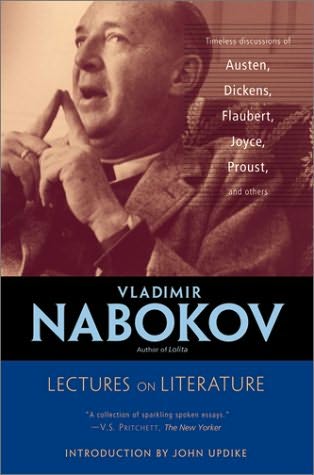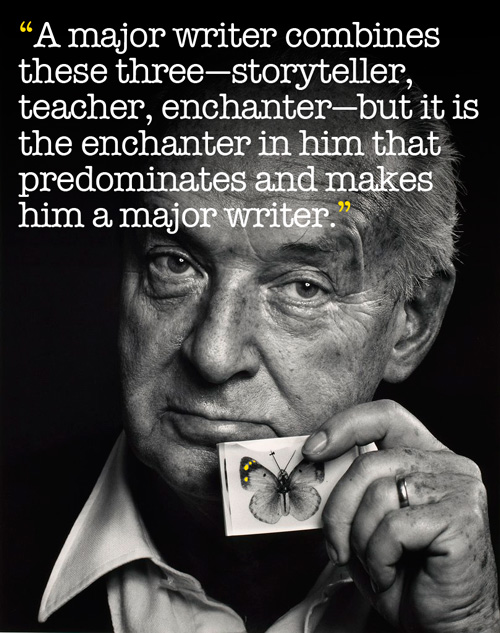Vladimir Nabokov
“Between the wolf in the tall grass and the wolf in the tall story there is a shimmering go-between. That go-between, that prism, is the art of literature.”
 “Often the object of a desire, when desire is transformed into hope, becomes more real than reality itself,” Umberto Eco observed in hismagnificent atlas of imaginary places. Indeedour capacity for self-delusion is one of the most inescapable fundamentals of the human condition, and nowhere do we engage it more willingly and more voraciously than in the art and artifice of storytelling.
“Often the object of a desire, when desire is transformed into hope, becomes more real than reality itself,” Umberto Eco observed in hismagnificent atlas of imaginary places. Indeedour capacity for self-delusion is one of the most inescapable fundamentals of the human condition, and nowhere do we engage it more willingly and more voraciously than in the art and artifice of storytelling.
In the same 1948 lecture that gave us Vladimir Nabokov’s 10 criteria for a good reader, found in his altogether fantastic Lectures on Literature(UK; public library), the celebrated author andsage of literature examines the heart of storytelling:
Literature was born not the day when a boy crying wolf, wolf came running out of the Neanderthal valley with a big gray wolf at his heels: literature was born on the day when a boy came crying wolf, wolf and there was no wolf behind him. That the poor little fellow because he lied too often was finally eaten up by a real beast is quite incidental. But here is what is important. Between the wolf in the tall grass and the wolf in the tall story there is a shimmering go-between. That go-between, that prism, is the art of literature.

He considers this essential role of deception in storytelling, adding to famous writers’ wisdom on truth vs. fiction and observing, as young Virginia Woolf did, that all art simply imitates nature:
Literature is invention. Fiction is fiction. To call a story a true story is an insult to both art and truth. Every great writer is a great deceiver, but so is that arch-cheat Nature. Nature always deceives. From the simple deception of propagation to the prodigiously sophisticated illusion of protective colors in butterflies or birds, there is in Nature a marvelous system of spells and wiles. The writer of fiction only follows Nature’s lead.Going back for a moment to our wolf-crying woodland little woolly fellow, we may put it this way: the magic of art was in the shadow of the wolf that he deliberately invented, his dream of the wolf; then the story of his tricks made a good story. When he perished at last, the story told about him acquired a good lesson in the dark around the camp fire. But he was the little magician. He was the inventor.
What’s especially interesting is that Nabokov likens the writer to an inventor, since the trifecta of qualities he goes on to outline as necessary for the great writer — not that different from young Susan Sontag’s list of the four people a great writer must be — are just as necessary for any great entrepreneur:
There are three points of view from which a writer can be considered: he may be considered as a storyteller, as a teacher, and as an enchanter. A major writer combines these three — storyteller, teacher, enchanter — but it is the enchanter in him that predominates and makes him a major writer.To the storyteller we turn for entertainment, for mental excitement of the simplest kind, for emotional participation, for the pleasure of traveling in some remote region in space or time. A slightly different though not necessarily higher mind looks for the teacher in the writer. Propagandist, moralist, prophet — this is the rising sequence. We may go to the teacher not only for moraleducation but also for direct knowledge, for simple facts… Finally, and above all, a great writer is always a great enchanter, and it is here that we come to the really exciting part when we try to grasp the individual magic of his genius and tostudy the style, the imagery, the pattern of his novels or poems.The three facets of the great writer — magic, story, lesson — are prone to blend in one impression of unified and unique radiance, since the magic of art may be present in the very bones of the story, in the very marrow of thought. There are masterpieces of dry, limpid, organized thought which provoke in us an artistic quiver quite as strongly as a novel like Mansfield Park does or as any rich flow of Dickensian sensual imagery. It seems to me that a good formula to test the quality of a novel is, in the long run, a merging of the precision of poetry and the intuition of science. In order to bask in that magic a wise reader reads the book of genius not with his heart, not so much with his brain, but with his spine. It is there that occurs the telltale tingle even though we must keep a little aloof, a little detached when reading. Then with a pleasure which is both sensual and intellectual we shall watch the artist build his castle of cards and watch the castle of cards become a castle of beautiful steel and glass.
Indeed, as important to the success of literature as the great writer is the wise reader, whom Nabokov characterizes by a mindset that blends the receptivity of art with the critical thinking of science:
The best temperament for a reader to have, or to develop, is a combination of the artistic and the scientific one. The enthusiastic artist alone is apt to be too subjective in his attitude towards a book, and so a scientific coolness of judgment will temper the intuitive heat. If, however, a would-be reader is utterly devoid of passion and patience — of an artist’s passion and a scientist’s patience — he will hardly enjoy great literature.

Lectures on Literature is a wealth of wisdom in its entirety. Also see Nabokov onthe six short stories everyone should read, then revisit famous writers’ collected insights on writing, including Elmore Leonard’s 10 rules of writing, Walter Benjamin’s thirteen doctrines, F. Scott Fitzgerald’s letter to his daughter,David Ogilvy’s 10 no-bullshit tips, Henry Miller’s 11 commandments, Jack Kerouac’s 30 beliefs and techniques, John Steinbeck’s 6 pointers, and Susan Sontag’s synthesized learnings.


No comments:
Post a Comment